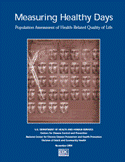Practical Applications for Prevention Research
How can the Healthy Days measures support epidemiologic and prevention research?
The validity, brevity, and comparability of the Healthy Days measures make them ideal additions to existing and new survey instruments to enhance opportunities for epidemiologic and prevention research.
Tracking health-related quality of life over time can help us better understand how the nation’s health is influenced by not only broad health and social policies but also disasters such as heat waves, cold snaps, floods, and even terrorist threats. The Healthy Days measures can predict short-term and long-term physician visits, hospitalization, and mortality among older adults, even after controlling for demographic factors and comorbidity. Because surveillance for health-related quality of life uses broad and sensitive measures, it can detect health problems that might not be captured by morbidity or mortality surveillance.
People with chronic disease such as arthritis, diabetes, epilepsy, and heart disease have worse HRQOL than those without these conditions. HRQOL helps researchers to ask, “Why is this happening? Is it pain? Is it loss of function? Is it comorbidity such as depression, or effects of treatment? Could differences be due to low levels of social support, education, or lack of insurance? Examining HRQOL data in relation to individual or community-level predictors can help answer some of these questions to inform interventions.
The addition of the core Healthy Days measures to the National Health and Nutrition Examination Survey (NHANES), beginning in 2000 and ending in 2012, has supported public health prevention goals. NHANES measures the national burden of preventable disease, injuries, and disabilities. It provides valuable new insights into the relationship between HRQOL and clinically-measured health characteristics and conditions such as blood pressure, physical strength and endurance, oral health, and mental health.
NHANES Healthy Days data allows researchers to validate people’s self-reports by comparing the NHANES objective measures of physical health and blood tests for interviewed subjects. NHANES studies of the levels of reported unhealthy days and activity limitation days in relation to measured body mass index and physical endurance, as well as to reported nutritional and physical activity patterns, can provide research-based messages to support related health communication objectives. The addition of the Healthy Days questions to NHANES has also extended the HRQOL surveillance to adolescents as well as adults and has yielded important information on the nature and extent of health disparities among geographic and socio-demographic groups. Learn more about NHANES.
